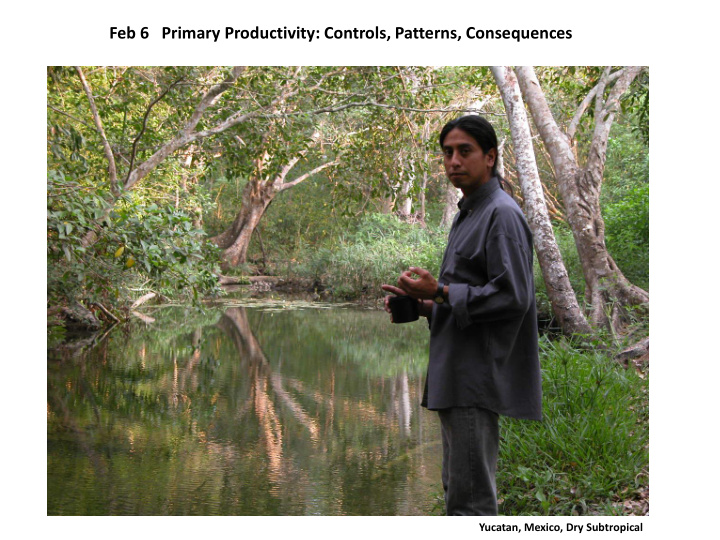



Feb 6 Primary Productivity: Controls, Patterns, Consequences Yucatan, Mexico, Dry Subtropical
History Hutchinson (1959), “What factors limit the number of species in a place ”? habitat heterogeneity - habitat area - trophic structure - evolutionary processes - available energy. -
History Hutchinson (1959), “What factors limit the number of species in a place ”? habitat heterogeneity - habitat area - trophic structure - evolutionary processes - available energy ( heat and the organic energy fixed by primary and secondary productivity) -
History Available energy • Little considered by conservation biologists. • Brown (1981) - Due to division of ecology in the 1970s into ecosystem ecology and community ecology. • But biogeographers made considerable progress in “species energy theory”. • Current consensus - continental-scale patterns of species richness are driven primarily by: • kinetic energy (heat) • potential energy (foods resulting from primary productivity) • habitat heterogeneity • availability of water • Ecologists are just coming around to better integrate energy flow into thinking on population and community ecology
Topics
Topics Trinidad, Wet Subtropical
Topics Definitions of ecosystem productivity Plant-level mechanisms and controlling factors Central Surinam Reserve, Wet Tropical Controlling ecosystem factors Spatial and temporal patterns within biomes Consequences Grand Teton NP, Wyoming, Temperate Coniferous
Primary Productivity Primary production - the production of organic compounds from atmospheric or aquatic carbon dioxide. Gross primary production (GPP)- the rate at which an ecosystem's producers convert radiant energy to organic molecules. Net primary production (NPP)- the rate at which all the plants in an ecosystem produce net useful chemical energy. NPP = GPP - respiration Cellular respiration – “burning of organic molecules to produce ATP to fuel growth and maintenance. Chapin et al. Fig 6.1 Net ecosystem production (NEP) - the balance between GPP and plant-plus-heterotrophic respiration.
Photosynthesis A chloroplast, showing the location of the major photosynthetic reactions. Chapin et al. Fig 5.4 CO 2 + H 2 O + light CH 2 O + O 2 Photosynthesis: Cellular respiration: C 6 H 12 O 6 + 6 O 2 → 6 CO 2 + 6 H 2 O ATP GPP – production of organic molecules NPP = GPP - respiration
The major factors governing temporal and spatial variation in GPP Chapin et al. Fig 5.2
The major factors governing temporal and spatial variation in GPP Chapin et al. Figs 5.10 and 5.5 CO2 Light
The major factors governing temporal and spatial variation in GPP Chapin et al. Fig 6.8
The major factors governing temporal and spatial variation in GPP Chapin et al. Fig 5.13
The major factors governing temporal and spatial variation in GPP Leaf area index (LAI) - equivalent to the total upper surface area of all leaves per area of ground. Ranges from 0 to 8 m 2 leaf/ m 2 ground. LAI is a key parameter governing ecosystem processes because it determines both the area that is potentially available to absorb light and the degree to which light is attenuated through the canopy. GPP correlates closely with leaf area below an LAI of about 4, suggesting that leaf area is a critical determinant of GPP on most of Earth’s terrestrial surface.
The major factors governing temporal and spatial variation in GPP Leaf area index (LAI) - equivalent to the total upper surface area of all leaves per area of ground. Ranges from 0 to 8 m 2 leaf/ m 2 ground. LAI is a key parameter governing ecosystem processes because it determines both the area that is potentially available to absorb light and the degree to which light is attenuated through the canopy. GPP correlates closely with leaf area below an LAI of about 4, suggesting that leaf area is a critical determinant of GPP on most of Earth’s terrestrial surface. What factors influence LAI?
The major factors governing temporal and spatial variation in GPP Summary - The major environmental factors that explain differences among ecosystems in carbon gain are the length of time during which conditions are suitable for photosynthesis and the soil resources (water and nutrients) available to support the production and maintenance of leaf area.
Variation within Biomes Paradise Valley, MT
Variation within Biomes: Spatial Primary Productivity across the GYE 6000 5000 Aboveground NPP (kg/ha/yr) 4000 3000 Low Elev Mid Elev 2000 High Elev 1000 0 Habitat Type Best Predictive model: Cover type, elevation*cover type, parent material Hansen et al. 1990
Variation within Biomes: Temporal Start of season Maximum NPP Cumulative NPP Length of season (EOS-SOS End of season NPP 0 365 Day of Year Metrics used to quantify phenology
Variation within Biomes: Temporal Spatial and Temporal Variation “Green Patches” across the Upper Yellowstone Watershed Piekielek in prep. April 23, 2010 June 10, 2010 August 29, 2010
Variation within Biomes: Temporal Effects of Land Use?
Variation within Biomes Central Surinam Reserve, Wet Tropical
Consequences of NPP
References Hansen, A.J., J.J. Rotella, M.L. Kraska and D. Brown. 2000. Spatial patterns of primary productivity in the Greater Yellowstone Ecosystem. Landscape Ecology. 15:505-522.
Recommend
More recommend